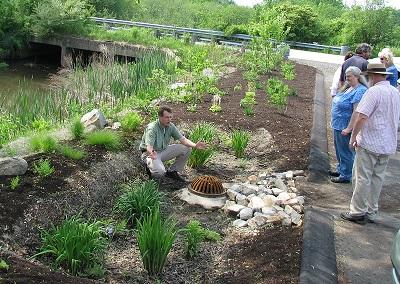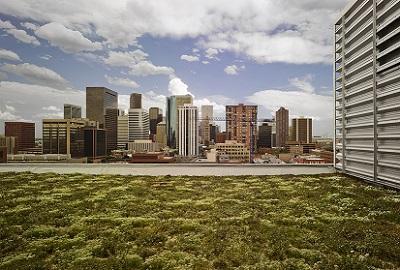EPA Science Matters Newsletter: RARE Partnerships Advance Green Infrastructure Research
EPA’s Regional Applied Research Effort program is helping local communities across the country study how green infrastructure can help them manage stormwater runoff.
EPA’s Regional Applied Research Effort (RARE) is a partnership program that unites Agency researchers with colleagues from across the country. Research is conducted collaboratively to match staff from each of EPA’s ten regional offices with Agency scientists and engineers in ways that leverage their collective technical expertise to meet environmental challenges. In addition to problem-solving, the program provides EPA scientists and support staff with valuable insight into the ongoing science needs of regional offices and the local communities they serve.
“The goal of RARE partnerships is to bring together many different people, with a diversity of expertise, in ways that facilitate collaborative research for high-priority science needs,” says Fred Hauchman, Ph.D., Director of EPA’s Office of Science Policy, which runs the program.
Support for green infrastructure research to help local communities better manage stormwater runoff is currently a major focus for the program. Examples of that work across the country are highlighted below.
New England (EPA Region 1)
Improving the Great Bay Estuary, New Hampshire
Agency researchers collaborated with stormwater managers in Dover, NH to conduct a performance analysis of a compact bioretention system and a subsurface gravel wetland. These two innovative stormwater control technologies, capable of efficiently removing phosphorus and nitrogen, were installed in the Berry Brook watershed, a tributary to the Cachero River which contributes to nutrient impairments in the Great Bay estuary. A computer simulation model of both controls will generate long-term total pollutant removal performance estimates.
Project findings will be particularly useful to New England communities struggling to find affordable and sustainable solutions to solve stormwater quality challenges. The results will add valuable information to the existing menu of stormwater management options, enabling managers to select the most appropriate and cost effective control practices.
 A rain garden in Region 1.
A rain garden in Region 1.Rain Gardens in New England
In densely developed New England cities where there is not enough space to install large stormwater retention facilities, rain gardens offer an attractive alternative. But how effective are they?
To answer that question, Agency scientists installed and analyzed rain gardens in New England communities. Each rain garden was equipped with buried instrumentation connected to data loggers to measure drainage properties, hydraulic capacity and performance. The findings are helping provide EPA and state permitting agencies with criteria for determining the amount of rain garden-generated credit to assign for stormwater permits.
New Jersey, New York, Puerto Rico, and the U.S. Virgin Islands (EPA Region 2)
Green Roofs for New York City, New York
Agency researchers designed an instrument for taking real-time measurements of the quantity and quality of stormwater runoff in urban environments, collecting data from six green roofs for more than 100 precipitation events over a 22-month period. Data from the green roofs were then compared with data from standard black rubber or silver roofs. Preliminary results indicate that, in comparison to standard roofs, green roofs retain between 40 and 70 percent of runoff per unit area. In addition to controlling stormwater runoff, green roofs also cool urban heat islands.
Rain Gardens in Edison, New Jersey
Rain gardens are one green infrastructure tool that many municipalities are building in high-density urban settings to capture and infiltrate runoff from parking lots, roofs, and roads. A more complete understanding of how they function will enable EPA to provide national guidelines on rain garden design, construction, maintenance, and monitoring. To help achieve that, researchers have installed six rain garden cells on EPA’s Edison, NJ laboratory facility. Their study is providing insight into the hydrologic performance of rain gardens, and how such performance changes based on the size of the drainage area served, the season, and the age of the garden.
The Midwest (EPA Region 7)
Monitoring the Impact of Green Infrastructure, Omaha, Nebraska
Agency researchers are working with partners from the USGS and the State of Nebraska to better understand how to monitor green infrastructure, and how this monitoring data can be used by cities and their sewer districts to adapt, improve, and maintain green infrastructure installations. The long-term data collection will provide insight into green infrastructure performance over the course of different storm conditions, and how installations respond to different stormwater volumes. Results will enhance the design and pilot implementation of a green infrastructure monitoring strategy to control stormwater overflows in Omaha.
Mountains and Plains (EPA Region 8)
 A green roof in Denver, Colorado.
A green roof in Denver, Colorado.Mile High Green Roofs for Denver, Colorado
EPA’s Region 8 headquarters, located in Denver is topped with a green roof: some 40,000 plants growing in a network of two-foot by four-foot modular trays. The roof was the focus of a collaborative research project that explored the practicability and environmental benefits of cultivating green roofs in such high, semi-arid climates.
The low precipitation, short periods of snow cover, low humidity, high wind velocities, and predominantly sunny days all add up to challenging growing conditions for many species of green roof plants. The project involved the evaluation of green roof stormwater management, mitigation of the urban heat island effect, and biological evaluation. The overall research strategy was to assist the development of green roof systems within the region’s urban communities.
